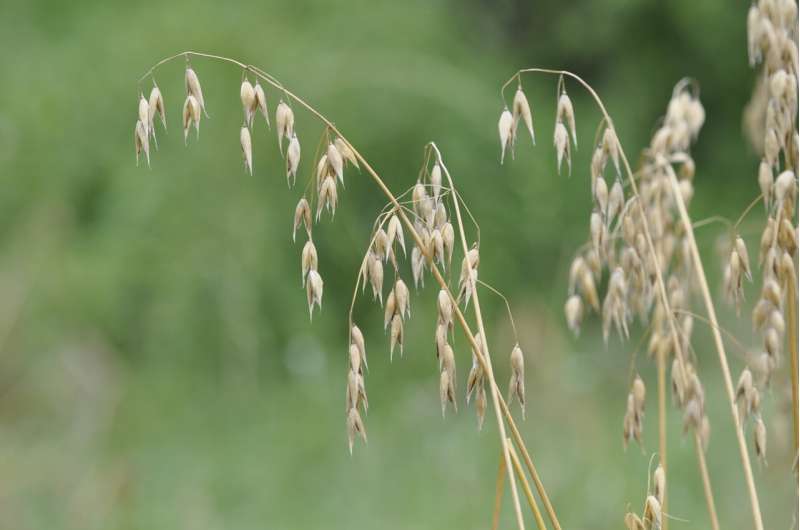
Oat, Avena sativa, is one of the top ten cereals crops in terms of global production. Credit: F. Welter-Schultes
Oat is among the top ten cereal crop species in terms of global production. It can adapt to different climates, and farmers can grow it successfully even in harsh environments where other crops such as rice and corn fail. However, not all oat plants are the same. Based on their grains, two major oat varieties can easily be distinguished: hulled, grains that are covered in a non-edible husk, and naked, grains that have a soft outer casing that easily separates from the edible grain during threshing.
To gain information on the origins of these different varieties, researchers in China have sequenced the genomes of over 100 oat plants from around the world. Their analyses indicate that unlike the current belief—that the two varieties came from one domestication event—the hulled and naked oat were domesticated independently. The work is published in the journal GigaScience.
It is believed that the common oat (Avena sativa), which today is grown all over the world, was domesticated in Europe around 3,000 years ago. In contrast, the origins of naked oat, which today is grown mainly in China, remain unclear. Many researchers regard naked oat as a variant of hulled oat, speculating that a mutation occurred after hulled oat was introduced into China. However, new population genomic data generated and analyzed by the laboratory of Prof. Bing Han at Inner Mongolia Agricultural University (IMAU) tell a different story.
Rather than being a variant of common oat that separated relatively recently, the authors estimate that hulled oat and naked oat diverged around 51,000 years ago. They therefore speculate that the two varieties were domesticated independently a long time ago, rather than one being a recent derivative of the other. The analyses in the study include a set of whole genome sequences, including 89 naked oat and 22 hulled oat plants, as well as four other closely related hexaploid species from around the world.
Additional findings in this study arising from a deeper analysis of this large data set support this view. For example, if naked oat had split recently from hulled oat, geneticists would have expected to see traces of a population bottleneck in the naked oat, which would have reduced the genetic diversity in the naked oat population. However, the scientists found the opposite: in their data: The genetic diversity of naked oat is higher than that of hulled oat, not the other way around.
The overall picture emerging from the data still remains rather complex, Prof. Bing Han explains, “The breeding of naked oat in China has gone through phases, including the direct collection and utilization of landraces, cross-breeding between naked oat varieties, and cross-breeding of naked oat with hulled oat.” All of this can increase the intricacy of the findings, leaving a great deal more to discover about the genetic history of naked oat.
The findings in this work demonstrate the power of large-scale genome sequencing to improve understanding of the domestication history of one of the major crop species that is feeding the world today.
More information:
Bing Han, Genome resequencing reveals independent domestication and breeding improvement of naked oat, GigaScience (2023). DOI: 10.1093/gigascience/giad061. academic.oup.com/gigascience/a … /gigascience/giad061
Nan Jinsheng et al, Supporting data for “Genome resequencing reveals independent domestication and breeding improvement of naked oat”, GigaScience Database (2023). DOI: 10.5524/102412
dx.doi.org/10.5524/102412
Provided by
GigaScience
Citation:
Genome data rewrite the story of oat domestication in China (2023, July 31)
retrieved 31 July 2023
from https://phys.org/news/2023-07-genome-rewrite-story-oat-domestication.html
This document is subject to copyright. Apart from any fair dealing for the purpose of private study or research, no
part may be reproduced without the written permission. The content is provided for information purposes only.
>>> Read full article>>>
Copyright for syndicated content belongs to the linked Source : Phys.org – https://phys.org/news/2023-07-genome-rewrite-story-oat-domestication.html






























